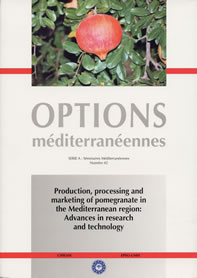| Article précédent | p. 231-235 | Article suivant |
Pharmacological and therapeutic properties of pomegranate
The cross-cultural and ethnobotanical embodiments of pomegranate (Punica granatum) are reviewed. A symbol of fecundity and divine femininity emerges, whose fruit rinds, bark and roots are used worldwide as taenicides, owing to alkaloids, and treatment of diarrhea and oral and genital lesions, owing to tannins and astringency. The seeds contain an oil which contains not only the steroidal estrogen, estrone, in the highest concentration found in any botanical species, but also a full range of non-steroidal phytoestrogens including the comesten, coumestrol, and the isoflavones, genistein and daidzein. Both the juice and the oil contain numerous and diverse bioflavonoids, which have been shown to be both potently antioxidant and inhibitory of one or both of the enzymes cyclooxygenase (catalyzing arachidonic acid to prostaglandins) and lipoxygenase (catalyzing arachidonic acid to leukotrienes).
- [ Afficher ]
- [ Télécharger ]
- [ Exporter la citation ]
Vous pouvez télécharger la citation au format :
- [ Imprimer ]
-
Mots-clés
ANTIOXYDANT, GENISTEINE, GRENADE FRUITS, OESTROGENECiter cet article
Lansky E., Shubert S., Neeman I. Pharmacological and therapeutic properties of pomegranate. In : Melgarejo P. (ed.), Martínez-Nicolás J.J. (ed.), Martínez-Tomé J. (ed.). Production, processing and marketing of pomegranate in the Mediterranean region: Advances in research and technology. Zaragoza : CIHEAM, 2000. p. 231-235. (Options Méditerranéennes : Série A. Séminaires Méditerranéens; n. 42). Symposium on 'Production, processing and marketing of pomegranate in the Mediterranean region: Advances in research and technology', 1998/10/15-17, Orihuela (Spain). http://om.ciheam.org/om/pdf/a42/00600277.pdf



